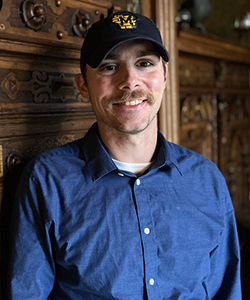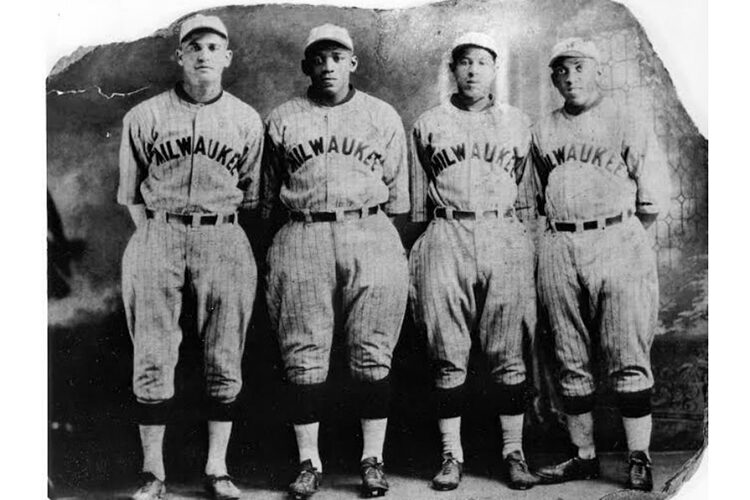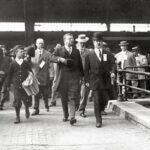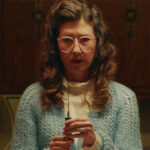Milwaukee once had its own team in the Negro Leagues.
The Milwaukee Bears, formed in 1923, only lasted one year, so their memory and accomplishments became a minor footnote in baseball history.
However, Ken Bartelt, a doctoral student in the University of Wisconsin-Milwaukee’s history program, is working to spotlight the role of the Bears and other Negro League teams in America’s complex approach to baseball and race.
He did his master’s thesis – “Brew City Black Ball: Milwaukee as Microcosm of the Early-Twentieth Century Black Baseball Experience” – on the history of the Negro Leagues in Milwaukee. Over the summer he was interviewed for a PBS story. PBS was filming a show about the Mallards, a Madison amateur baseball team that plays in the Northwoods League, which did a tribute to the Bears.

“My areas are race and American history and society, but I like to do it through the lens of sports. I think things we might call pop culture are a really great way to get people interested in history.”
Bartelt, who grew up in Buffalo Grove, Illinois, combines his lifelong love of baseball and a passion for history in his work. Neal Pease, a now-retired UWM professor of history who taught a course on baseball and American history, inspired him to use his interest in baseball to look at how history influences contemporary issues.
With his research on the baseball’s Negro Leagues, he says, “we’re talking about baseball, but we’re really talking about race in America. We’re talking about labor relations and the immigrant experience; we’re talking about business economic history. I just think baseball, being America’s pastime, is a great way to learn about history.”
A country divided
The Negro Leagues and the Milwaukee Bears highlight an era when America and its sports teams were divided along color lines.
“A lot of teams do tribute nights, but they don’t really talk much about how these leagues were formed and how they struggled to operate in Jim Crow America,” Bartelt said. “They really became one of the first and most successful nationwide Black institutions.”
When he first started researching the topic, Bartelt found a “glaring void” about Milwaukee’s contributions to the Negro Leagues. Baseball histories mentioned the city had a team in 1923, but they didn’t talk about it at any depth. The Milwaukee Brewers had unearthed one historic photo of the team, but not much was known about the team.
He also found that a highly successful all-Black traveling team, the McCoy-Nolan Giants, was based in Milwaukee. They were sponsored by a white owner, John R. McCoy’s plumbing supply company.
“They aren’t mentioned anywhere, but they had tremendous success, winning 80% of the games they played throughout the country and overseas and in Cuba and Canada, Bartelt said. “They won the California midwinter tournament in 1930, which was the biggest semi-pro tournament in the country.”
Absent from history
Both teams are largely absent from Milwaukee baseball literature.
“That was one of the blessings, but also the challenges of this work – that nothing had been done before. But it allowed me to kind of interpret the primary sources and make arguments and claims.”
Those primary sources included 400-plus newspaper articles in online archives – the pandemic year worked in his favor for that, said Bartelt, who finished his thesis and earned his master’s in public history and museum studies in the summer of 2020.
He also was able to interview Dennis Biddle, who founded and runs an organization called Yesterday’s Negro League Players Association. Biddle, a UWM alum who lives in Milwaukee and played for the Chicago American Giants, talked about his experiences in the Negro Leagues. He had also become friends with some of the Bears players later in their lives, giving Bartelt some insights into Milwaukee in the 1920s and the impact of the dual white and Black economies.
Primarily white crowds
Biddle mentioned that the Bears often played for predominately white crowds because Milwaukee’s Black population was relatively small at the time.
In 1923, less than a half a percent of Milwaukee’s population was Black. “It was really not a conducive market for Negro League baseball, because the Negro League teams were reliant on Black patronage, while some of these traveling teams would go to these little all-white towns and everyone would come out to see them. As an actual franchise, they needed a Black customer base and Milwaukee didn’t have that in 1923. That’s one reason why the team failed.”
And, in spite of all the challenges, the story of the Negro Leagues is also a story of perseverance, Bartelt said. “These men, and one woman (Effa Manley), who owned some of these teams – they came together to build something that meant a lot to their communities and employed a lot of people. They provided entertainment for people for decades, even during the Jim Crow period.”
He sees value in studying the past to prepare for the future, and, as a white scholar, he sees himself as an ally in telling people about this particular slice of history. “It’s about seeing this story that needs to be told. I have the tools to tell it and I want to share that with everybody.”
“The story of the Negro Leagues is an important reminder of a time in our history when we were quite literally racially divided. If we as a nation are going to reckon with our racial past and the contemporary issues we have, we need to reckon with that.”







